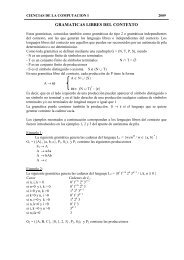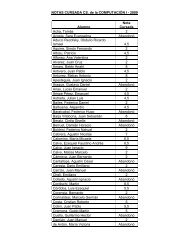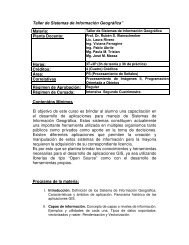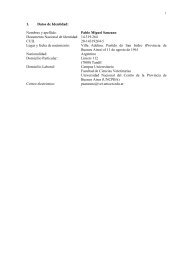Libro de Resúmenes / Book of Abstracts (Español/English)
Libro de Resúmenes / Book of Abstracts (Español/English)
Libro de Resúmenes / Book of Abstracts (Español/English)
You also want an ePaper? Increase the reach of your titles
YUMPU automatically turns print PDFs into web optimized ePapers that Google loves.
Resumenes 142<br />
ser mo<strong>de</strong>lado <strong>de</strong> otras formas (ver Thieme 2003, Wang et al .1999, Zhou<br />
et al. 2005).<br />
El mo<strong>de</strong>lo que estudiamos es <strong>de</strong>scrito por el sistema <strong>de</strong> ecuaciones<br />
diferenciales <strong>de</strong>l tipo Kolmogorov (Freedman 1980)<br />
⎧<br />
2<br />
dx ⎛ x ⎞ qx<br />
⎪ = r⎜1<br />
− ⎟(<br />
x − m)<br />
x − y 2<br />
⎪ dt ⎝ K ⎠ x + a<br />
⎪<br />
X µ : ⎨<br />
⎪<br />
2<br />
⎪dy<br />
⎛ px ⎞<br />
=<br />
⎪ ⎜ − c ⎟ y<br />
2<br />
⎩ dt ⎝ x + a ⎠<br />
don<strong>de</strong> x = x(t) e y = y(t) indican los tamaños poblacionales (número<br />
<strong>de</strong> individuos, <strong>de</strong>nsidad o biomasa) <strong>de</strong> las presas y <strong>de</strong>predadores<br />
respectivamente, y todos los parámetros son positivos, teniendo diferentes<br />
significados y por razones biológicas a y m < K. Si m = 0, se dice que la<br />
población está afectada por el efecto Allee débil (González-Olivares et al.<br />
2005).<br />
Obtenemos condiciones en los parámetros para<br />
a) Determinar cantidad <strong>de</strong> los puntos <strong>de</strong> equilibrio en el primer<br />
cuadrante.<br />
b) Determinar la naturaleza <strong>de</strong> los puntos críticos.<br />
c) Establecer la existencia <strong>de</strong> curvas separatrices, curvas<br />
homoclínicas o heteroclínicas.<br />
d) Determinar la cantidad <strong>de</strong> ciclos límites<br />
Implications <strong>of</strong> the Allee effect in a Gause type predator-prey<br />
mo<strong>de</strong>ls with sigmoid functional response<br />
In this work we analize a <strong>de</strong>terministic continuous-time predator-prey<br />
mo<strong>de</strong>ls <strong>of</strong> Gause type (Freedman, 1980) consi<strong>de</strong>ring two important aspects:<br />
En este trabajo analizamos un mo<strong>de</strong>lo <strong>de</strong> <strong>de</strong>predación <strong>de</strong>terminista<br />
tiempo continuo que se i) The functional response o consumption rate is<br />
Holling type III or sigmoid (Turchin, 2003)<br />
ii) In the prey growth function the Allee effect it is consi<strong>de</strong>red.<br />
A study for this type <strong>of</strong> mo<strong>de</strong>ls is maked in (Conway and Smoller<br />
1986), but some <strong>of</strong> its results are not fulfilled in the mo<strong>de</strong>l that we study.<br />
In Population Dynamic, any ecological mechanism that can lead to a<br />
positive relationship between a component <strong>of</strong> individual fitness and either<br />
the number or <strong>de</strong>nsity <strong>of</strong> conspecifics can be termed a mechanism <strong>of</strong> the<br />
Allee effect (Kent et al. 2003, Stephens and Sutherland 1999) or<br />
<strong>de</strong>pensation (Clark 1990, Dennis 1989), or negative competition effect<br />
(Wang et al. 1999).<br />
Populations can exhibit allee dynamics due to a wi<strong>de</strong> range <strong>of</strong><br />
biological phenomenon such as reduced antipredator vigilance, social<br />
thermoregulation, genetic drift (Stephens and Sutherland, 1999), mating<br />
difficulty (McCarthy 1997), and so on.<br />
The Allee effect is a important and interesting phenomenon in both<br />
biological and mathematical sense. From biological point wise, Allee effect it<br />
produces to low population <strong>de</strong>nsities when the individual growth rate is a<br />
increasing function with <strong>de</strong>nsity (Dennis 1989), and for this its possibilities<br />
<strong>of</strong> extinction increases (Courchamp et al. 1999); the importance <strong>of</strong> this


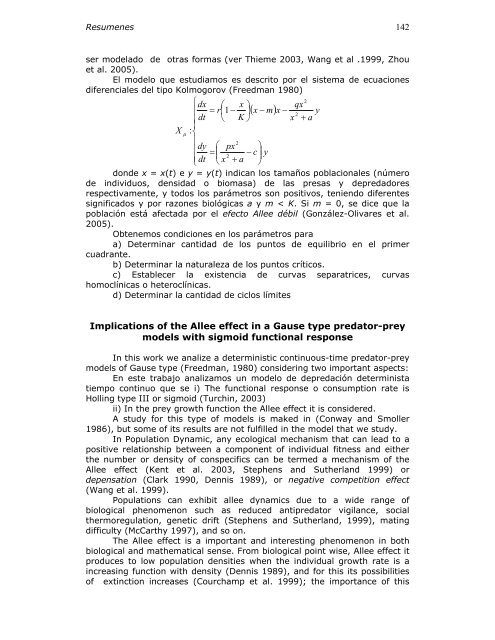
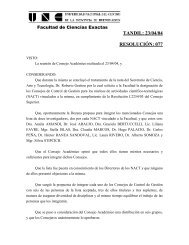
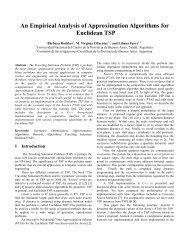
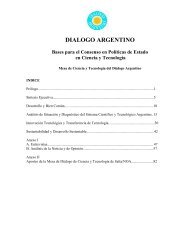
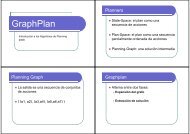
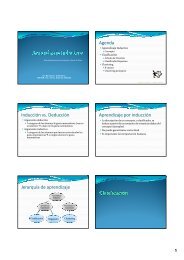
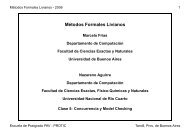
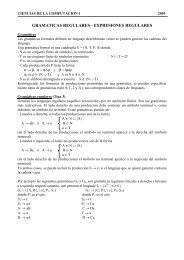
![Clase 13 [pdf]](https://img.yumpu.com/19616969/1/190x245/clase-13-pdf.jpg?quality=85)


